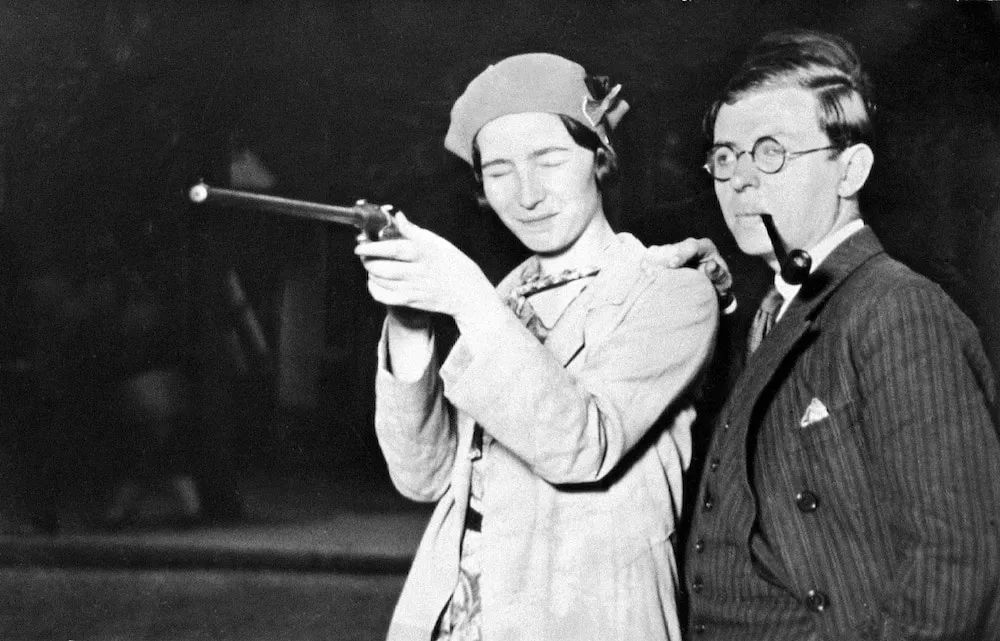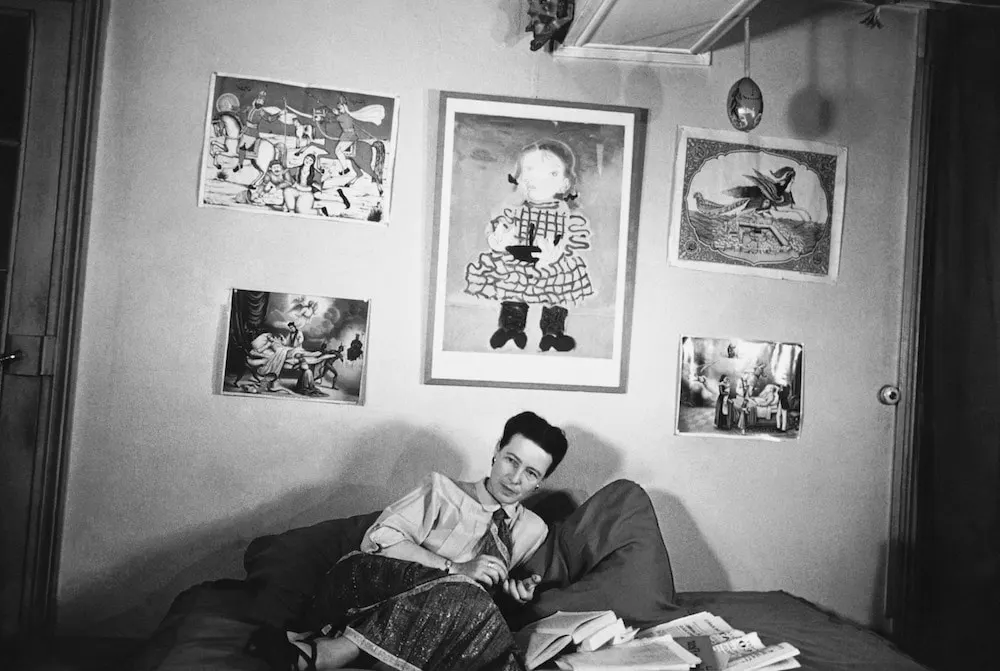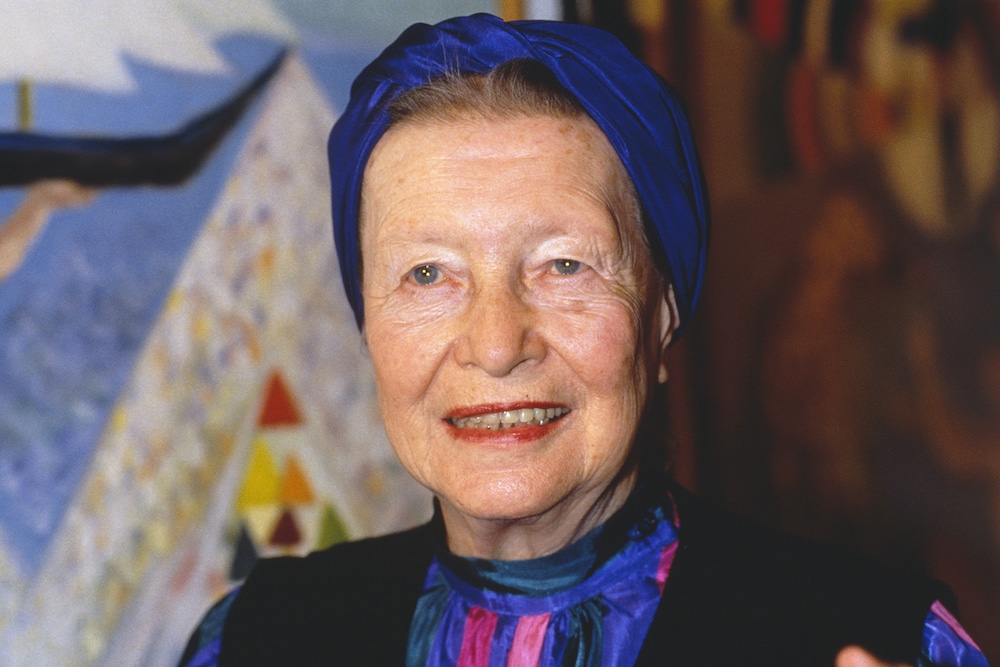Simone de Beauvoir at the opening of her sister Helène de Beauvoir’s exhibition of paintings in the 1980s. (Sygma via Getty/ Eric Préau)
We celebrate trailblazing feminist author and existentialist philosopher Simone de Beauvoir on her birthday.
Simone Lucie Ernestine Marie Bertrand de Beauvoir was born in Paris on 9 January, 1908.
She is best known for her groundbreaking work The Second Sex, published in 1949, which examined the patriarchy, oppression and what it means to be a woman.
She published essays, biographies, auto-biographies, monographs and even branched into fiction, continuing to write until her death in 1986.
Here are five fascinating facts you need to know about the feminist, existentialist and now LGBT+ icon.
1. Simone de Beauvoir once wanted to become a nun
Simone de Beauvoir was raised in a wealthy and strictly Catholic home with her younger sister Hélène, however after World War I, her family lost most of their money.
Despite this, her mother was intent on upholding their bourgeois lifestyle, and the young de Beauvoir was educated in elite convent schools.
As a child, her Catholic beliefs were so strong that she expressed her desire to become a nun. However, her increasing interest in philosophy and understand of the injustice in the world for women, she had a crisis of faith and became an atheist at the age of 14.
After secondary school, although not enrolled, she sat in on lectures at the prestigious École Normale Supérieure, determined to sit the agrégation, a high-level exam, in philosophy.
At 21, she became the ninth woman ever to pass it and the youngest person ever to do so.
2. The philosopher was one of the first intellectuals to differentiate between sex and gender
In 1949, Simone de Beauvoir published her best-known work – Le Deuxième Sexe, or The Second Sex.
The book, almost 1,000 pages long, was published in two volumes, and discusses the history of the oppression of women, the patriarchy and what it means to be a woman.
In The Second Sex, de Beauvoir became one of the first known intellectuals to discuss the distinction between sex and gender, and wrote the iconic line: “One is not born but becomes a woman.”
She insisted that womanhood was not born of biology, but was a gender identity that was built over time. Her idea of gender as a historical and social construct, contributed to our modern understanding of gender identity, and the trans experience.
3. Simone de Beauvoir was bisexual, and spent her life in open relationships
While studying at the École Normale Supérieure in 1929, Simone de Beauvoir met existentialist philosopher Jean-Paul Sartre.
The pair had a life-long companionship, remaining partners until Sartre’s death in 1980, although they never married. Their relationship was never monogamous and de Beauvoir experienced many other relationships and lovers during her lifetime.

Around the same time she met Sartre, she also met Elisabeth Lacoin, nicknamed “Zaza”, who is widely considered her first love, and the pair had a “passionate and tragic” relationship.
Throughout her life, de Beauvoir had multiple female lovers, and also took part in threesomes.
4. Her semi-autobiographical queer love story Les Inséparables remained unpublished until 2020
In 2020, a novel that was finished by Simone de Beauvoir in 1954 was finally published.
According to AFP, the 2Seas literary agency which handled foreign rights Les Inséparables described the book as a “moving, gripping coming-of-age novel”, which tells the love story of de Beauvoir and her first love, Zaza.
The novel “outlines Simone de Beauvoir’s personal battle against the conventional expectations”, and sees her do “her all in order to make Andree (a thinly-disguised Zaza) love her back”.
The book was thought to be “too intimate” for publication during de Beauvoir’s lifetime.
In it, she tells Zaza, who died from brain inflammation at the age of 21: “From the day I met you, you were everything for me.”

4. Her ideas have inspired intersectional feminist academics and queer theory
Her lasting influence on feminist and existentialist theory is widely-known, but Simone de Beauvoir has also laid the groundwork for much of the queer theory we know about today.
Feminist academic Judith Butler studied de Beauvoir’s work in her 1990 book Gender Trouble, a text that proved foundational to the development of queer theory.
They expanded on de Beauvoir’s ideas on gender as a social construct, developing the concept of gender performativity and the changing nature of gender.
In a 2021 interview with The Guardian, Butler reflected on Gender Trouble 31 years after its publication, and said: “The category of woman can and does change, and we need it to be that way.
“Politically, securing greater freedoms for women requires that we rethink the category of ‘women’ to include those new possibilities.
“The historical meaning of gender can change as its norms are re-enacted, refused or recreated. So we should not be surprised or opposed when the category of women expands to include trans women.”
